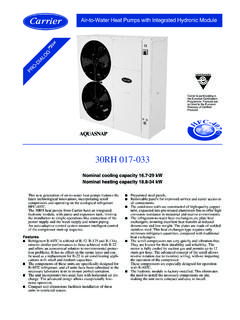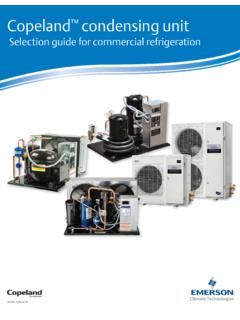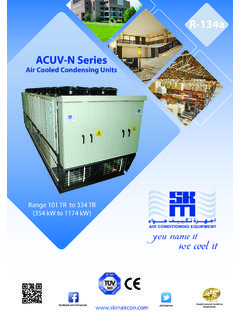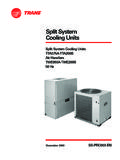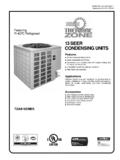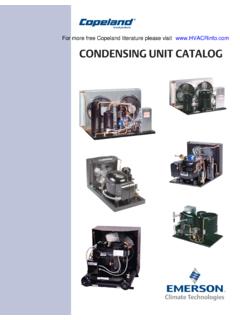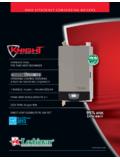Transcription of 38RA 040-160 Air-Cooled Condensing Units - Acare
1 38RA 040-160 . Air-Cooled Condensing Units Nominal cooling capacity 40-151 kW. 50 Hz AQUASNAP. For the operation of the control please refer to the Pro-Dialog Control manual for the 38RA series Installation, operation and maintenance instructions The cover graphic is for illustrative purposes only and is not part of any offer for sale or contract. 2. CONTENTS. 1 - INTRODUCTION .. 4. - Installation safety considerations .. 4. - Equipment and components under pressure .. 4. - Maintenance safety considerations .. 4. - Repair safety considerations .. 5. 2 - PRELIMINARY CHECKS .. 6. - Check equipment received .. 6. - Moving and siting the unit .. 6. 3 - DIMENSIONS/CLEARANCES .. 8. 4 - PHYSICAL DATA .. 10. 5 - ELECTRICAL DATA .. 10. 6 - APPLICATION DATA .. 11. - 38RA unit operating range.
2 11. 7 - ELECTRICAL CONNECTION .. - Power supply .. 12. - Voltage phase imbalance (%) .. 12. 8 - RECOMMENDED WIRE SECTIONS .. 13. - Field control wiring .. 13. 9 - REFRIGERANT PIPING .. 14. - General recommendations for field installation, thermostatic expansion valve (TXV) and solenoid valve .. 14. - Installation of piping .. 14. - Evaporator coil selection .. 14. 10 - REFRIGERANT PIPE SIZING .. 15. - General .. 15. - Use of pipe sizing diagrams .. 15. - Suction pipe sizing .. 15. 11 - START-UP .. 18. - Preliminary checks .. 18. - Actual start-up .. 18. - Refrigerant charge adjustment .. 18. 12 - MAINTENANCE .. 18. - Maintenance of the refrigerant circuit .. 18. - Electrical maintenance .. 19. - Condenser coil .. 20. 13 - AQUASNAP MAINTENANCE PROGRAM .. 21. 14 - START-UP CHECKLIST FOR 38RA Condensing Units (USE FOR JOB FILE).
3 23. 3. 1 - INTRODUCTION The safety valves must be connected to discharge pipes. These pipes must be installed in a way that ensures that people and Prior to the initial start-up of the 38RA Units , the people property are not exposed to refrigerant leaks. These fluids involved in the on-site installation, start-up, operation, and may be diffused in the air, but far away from any building air maintenance of this unit should be thoroughly familiar with intake, or they must be discharged in a quantity that is these instructions and the specific project data for the appropriate for a suitably absorbing environment. installation site. Periodic check of the globe valves: See paragraph The 38RA Condensing Units are designed to provide a very Maintenance safety considerations.
4 High level of safety during installation, start-up, operation and maintenance. They will provide safe and reliable service when Accumulation of refrigerant in an enclosed space can operated within their application range. displace oxygen and cause asphyxiation or explosions. This manual provides the necessary information to familiarize Inhalation of high concentrations of vapour is harmful and yourself with the control system before performing start-up may cause heart irregularities, unconsciousness, or death. procedures. The procedures in this manual are arranged in the Vapour is heavier than air and reduces the amount of oxygen sequence required for machine installation, start-up, operation available for breathing. These products cause eye and skin and maintenance.
5 Irritation. Decomposition products are hazardous. Be sure you understand and follow the procedures and safety - Equipment and components under pressure precautions contained in the instructions supplied with the machine, as well as those listed in this guide. These products incorporate equipment or components under pressure, manufactured by Carrier or other manufacturers. We - Installation safety considerations recommend that you consult your appropriate national trade association or the owner of the equipment or components After the unit has been received, when it is ready to be installed under pressure (declaration, re-qualification, retesting, etc.). or reinstalled, and before it is started up, it must be inspected The characteristics of this equipment/these components are for damage.
6 Check that the refrigerant circuit(s) is (are) intact. given on the nameplate or in the required documentation, Ensure especially that no components or pipes have shifted supplied with the products. ( following a shock). If in doubt, carry out a leak tightness check and verify with the manufacturer that the circuit integrity - Maintenance safety considerations has not been impaired. If damage is detected upon receipt, immediately file a claim with the shipping company. Engineers working on the electric or refrigeration components must be authorized, trained and fully qualified to do so. Do not remove the skid or the packaging until the unit is in its final position. These Units can be moved with a fork lift truck, All refrigerant circuit repairs must be carried out by a trained as long as the forks are positioned in the right place and person, fully qualified to work on these Units .
7 He must have direction on the unit . been trained and be familiar with the equipment and the installation, and he must wear the necessary protective items The Units can also be lifted with slings, using only the (gloves, glasses, protective clothes, safety shoes). designated lifting points marked at the four corners at the unit base. Soldering and welding: Component, piping and connection soldering and welding operations must be carried out using the These Units are not designed to be lifted from above. Use correct procedures and by qualified operators. Pressurised slings with the correct capacity, and always follow the lifting containers must not be subjected to shocks, nor to large instructions on the certified drawings supplied with the unit . temperature variations during maintenance and repair operations.
8 Safety is only guaranteed, if these instructions are carefully Never work on a unit that is still energized. followed. If this is not the case, there is a risk of material deterioration and injuries to personnel. Never work on any of the electrical components, until the general power supply to the unit has been cut using the Never cover any safety devices. disconnect switch in the control box. The 38RA Units are supplied without a safety globe valve in the If any maintenance operations are carried out on the unit , refrigerant circuit. During the installation this safety valve lock the power supply circuit in the open position ahead of must be installed to ensure protection against fire risk. the machine. These valves must be selected in accordance with standard If the work is interrupted, always ensure that all circuits are EN 13136, and the unit compressor(s) must be taken into still deenergized before resuming the work.
9 Consideration. The compressors are regarded as reservoirs that can contain liquid refrigerant. 4. ATTENTION: Even if the compressor motors have been Never exceed the specified maximum operating pressures. switched off, the power circuit remains energized, unless the Verify the allowable maximum high- and low-side test unit or circuit disconnect switch is open. Refer to the wiring pressures by checking the instructions in this manual and the diagram for further details. Attach appropriate safety labels. pressures given on the unit name plate. Operating checks: During the life-time of the system, Do not use air for leak testing. Use only refrigerant or dry inspection and tests must be carried out in accordance with nitrogen. national regulations. Do not unweld or flamecut the refrigerant lines or any The information on operating inspections given in annex C of refrigerant circuit component until all refrigerant (liquid and standard EN378-2 can be used if no similar criteria exist in vapour) has been removed from unit .
10 Traces of vapour the national regulations. should be displaced with dry air nitrogen. Refrigerant in contact with an open flame produces toxic gases. Safety device checks (annex C6 EN378-2): The safety devices must be checked on site once a year for safety devices The necessary protection equipment must be available, and (high-pressure switches), and every five years for external appropriate fire extinguishers for the system and the overpressure devices (safety globe valves). refrigerant type used must be within easy reach. Contact Carrier Service for a detailed explanation of the Do not siphon refrigerant. high-pressure switch test method. Avoid spilling liquid refrigerant on skin or splashing it into If the machine operates in a corrosive environment, inspect the eyes.






